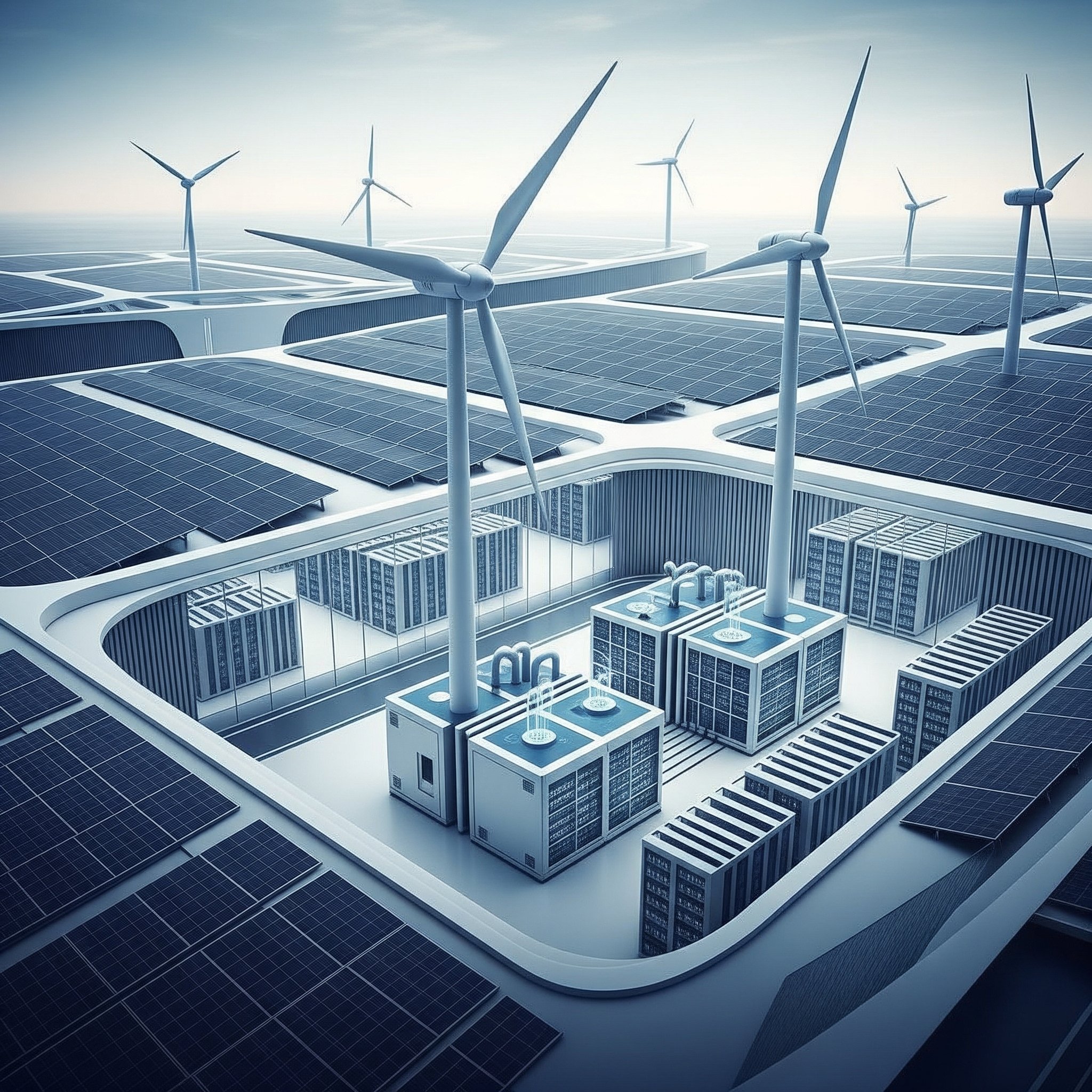A New Economic Model: From Centralized to Decentralized Power
The traditional energy system is a centralized model. A few large power stations generate electricity, which is then transmitted and distributed to consumers via a national grid. Energy suppliers act as intermediaries, managing transactions and customer relationships.
A trustless network, however, flips this model on its head. It enables a decentralized system where a secure, shared digital ledger automatically records and validates energy transactions.
The Invisible Backbone: Why a Digital Electric Framework is Non-Negotiable for National Energy Digitalization
The global energy landscape is undergoing a monumental transformation. Driven by the urgent need for decarbonization, the proliferation of renewable energy sources, and the relentless demand for efficiency, nations worldwide are embarking on the journey of energy sector digitalization. Yet, at the heart of this intricate evolution, often overlooked, lies a critical enabler: the Digital Electric Framework. This isn't merely a technological upgrade; it is the invisible backbone, the nervous system that records and interprets the ceaseless pulse of energy flow across an entire nation's electricity network, from the behemoth generators to the smallest household appliance.
Imagine trying to manage a complex organism without understanding its vital signs. That, in essence, is the challenge facing traditional electricity grids. They are often characterized by disparate systems, limited real-time data, and a top-down operational model. As we pivot towards a future defined by distributed generation, bi-directional energy flow, and active consumer participation, this traditional model falters. This is precisely where a robust Digital Electric Framework becomes not just beneficial, but absolutely indispensable.
The Road Ahead for National Energy Productivity
The drive for greater energy productivity is a global imperative, crucial for economic competitiveness, environmental sustainability, and national security. For nations with ambitious net-zero targets and a rapidly evolving energy landscape, finding innovative solutions is paramount. While traditionally managed by centralized utilities, a new paradigm is emerging, one where Blockchain and Decentralized Autonomous Organizations (DAOs) stand to radically transform how a nation generates, distributes, and consumes energy, ultimately supercharging its energy productivity.
Currently, our energy systems, from the sprawling grids to local power networks, are often characterized by inefficiencies, opacity, and a reliance on intermediaries. This leads to wasted energy, higher costs, and a slower transition to renewable sources. Imagine a future where every kilowatt-hour is tracked, traded, and optimized in real-time – that's the new reality blockchain and DAOs bring to the energy sector.
The Modern Energy Grid is Decentralized and Smart
The modern energy grid stands at a critical juncture, facing an escalating barrage of threats from extreme weather events, devastating wildfires, and the inherent volatility of a rapidly evolving energy market. The traditional, centralized approach to grid management, characterized by reactive responses, is inadequate. A fundamental shift towards proactive grid hardening, powered by unparalleled situational awareness, is not just desirable—it's essential for ensuring a stable and reliable energy future. Enter blockchain technology, poised to revolutionize how we monitor, manage, and fortify our energy infrastructure against these formidable challenges.
The Regulator's New Role: From Gatekeeper to Enabler
For decades, the relationship between energy consumers and suppliers has been largely one-sided. Centralized utilities generate and distribute power, while consumers passively receive it, often navigating opaque billing and limited choices. But a technological revolution is placing power—both literally and figuratively—back into the hands of the people. This revolution is built on blockchain and governed by Decentralized Autonomous Organizations (DAOs), and energy regulators hold the key to unlocking its potential.
The Old Grid: A Monologue in a World That Needs a Dialogue
The global energy system is undergoing its most profound transformation in a century. As we pivot away from centralized, fossil-fuel-based power generation towards a decentralized, renewable-powered future, the challenge is not merely technological. It is fundamentally a question of governance, equity, and engagement. For too long, consumers have been passive recipients in a top-down system. A new paradigm, powered by technologies like blockchain and Decentralized Autonomous Organizations (DAOs), place current and future consumers at the very heart of shaping their own energy destiny.
Revolutionizing Energy Security: The Role of Blockchain and DAOs
The global energy landscape is undergoing a profound transformation, driven by the need for greater security, sustainability, and efficiency. As decentralized renewable energy sources like solar panels and wind turbines become more common, the traditional centralized grid model is becoming less tenable. This shift is creating a perfect environment for the emergence of two powerful technologies: blockchain and Decentralized Autonomous Organizations (DAOs). Together, they are introducing a new paradigm for energy security by enhancing transparency, democratizing access, and streamlining efficiency.
The Evolving Role of a TSO in a Nation of Microgrids
In the 20th century, the electricity grid was a model of centralized authority. Power flowed in a predictable, one-way street from massive, central power plants, through a high-voltage transmission network, and down to passive consumers. The Transmission System Operator (TSO) was the master of this system, acting as a single point of command and control to ensure a reliable and secure power supply.
Today, however, the energy landscape is being redrawn by a new force: the microgrid. These small, localized power systems, often combining renewable sources, energy storage, and local loads, represent a fundamental shift towards decentralization. They can operate independently of the main grid (in "island mode") or connected to it, fundamentally changing the traditional flow of power.
This paradigm shift forces the TSO to abandon its role as a master and embrace a new one: the conductor of a decentralized symphony. In a nation covered by microgrids, the TSO's core responsibilities remain, but their implementation and complexity are completely transformed.
How a Digital Electric Framework and AI Can Unleash the Self-Healing Grid
The dream of a truly "self-healing grid" – an electrical network that automatically detects, isolates, and repairs faults with minimal human intervention – is rapidly moving from concept to reality. While advanced sensors and artificial intelligence (AI) are pivotal to this transformation, a crucial, often overlooked component is the backbone for this intelligent grid: a Digital Electric Framework for energy data.
Unlocking the Power of Decentralization for Consumers
The energy landscape is undergoing a profound transformation, shifting from a centralized model dominated by large power plants to a more dynamic, decentralized system fueled by renewable sources and empowered prosumers (consumers who also produce energy). At the forefront of this revolution lies the convergence of blockchain technology and energy management, with a decentralized energy management system (DEMS) owned and overseen by a national energy regulator. This innovative approach promises a paradigm shift for energy consumers, offering unprecedented transparency, control, and efficiency.
The Data Conundrum for Distribution System Operators
Distribution System Operators face a multifaceted data challenge. The increasing penetration of distributed energy resources (DERs) like solar panels and electric vehicles, coupled with the ongoing digitalization of the grid, generates vast amounts of data. Managing this data effectively is crucial for maintaining grid stability, optimizing energy flow, and facilitating market transactions.
Powering Progress: Digital Electric Framework
The electricity flowing through our national grids is more than just a means to power our devices; it's a dynamic, complex system. National electric flow data, increasingly granular and real-time thanks to smart technologies, offers unparalleled insights into this system. However, to truly harness its power and navigate the complexities of a rapidly evolving energy landscape, a coordinated, robust National Digital Electric Framework is not just beneficial, but becoming essential.
How to foster Decentralization, enhance Transparency, and significantly improve Efficiency
The energy sector, traditionally dominated by centralized entities, is ripe for disruption. The rise of blockchain technology and Decentralized Autonomous Organizations (DAOs) presents a transformative opportunity to foster decentralization, enhance transparency, and significantly improve efficiency. These innovations are reshape how energy is produced, distributed, and consumed, moving towards a more resilient, equitable, and sustainable future.
A Digital Powerhouse: How Regulator-Owned Digital Frameworks Can Electrify National Climate Targets
The race to net-zero emissions is intensifying, and at its heart lies the urgent transformation of our energy systems. While ambitious targets are being set, the practical path to decarbonization hinges on a smarter, more agile, and deeply interconnected electricity grid. Imagine a future where this critical infrastructure is underpinned by a comprehensive digital framework, not just managed, but owned or meticulously overseen by the energy regulator. Such a paradigm shift could unlock unprecedented potential in achieving national climate targets.
On-site Power Generation
The digital age is running on an insatiable hunger for data, and at the heart of this demand are data centers – sprawling complexes that power everything from our social media feeds to the complex algorithms of artificial intelligence. But this growth comes with a formidable challenge: an unprecedented thirst for electricity that is beginning to strain traditional centralized power grids to their breaking point. The solution? A dramatic pivot towards on-site power generation, moving beyond mere backup to become the primary energy source for the internet's critical infrastructure. This isn't just an evolutionary step; it's a revolutionary shift, occurring at internet scale.
The Unshakeable Link: Why a Regulator-Owned National Digital Framework with Blockchain is Critical for Climate Action
Climate change presents the defining challenge of our era, demanding an unprecedented level of global coordination, transparency, and accountability. As nations grapple with ambitious mitigation targets and urgent adaptation needs, the traditional approaches to data management and oversight often fall short. This is where a groundbreaking solution emerges: a regulator-owned national digital framework, supercharged by blockchain technology.
At its core, addressing climate change effectively hinges on robust, verifiable, and accessible information. From tracking greenhouse gas emissions to monitoring carbon sequestration projects, ensuring the integrity of carbon markets, and verifying climate finance flows, the sheer volume and complexity of data are staggering. Current systems often suffer from fragmentation, lack of standardization, and susceptibility to manipulation, undermining trust and slowing progress.
Electricity as a Service (EaaS) and the Power of Distributed Information Systems
The energy sector is undergoing a profound transformation, moving away from a centralized, commodity-driven model towards a service-oriented paradigm known as Electricity as a Service (EaaS). This shift promises greater efficiency, resilience, and sustainability by allowing consumers to pay for the outcome of electricity consumption – reliable power, optimized usage, and enhanced grid independence – rather than just kilowatt-hours. Crucially, the successful widespread adoption and optimization of EaaS will heavily rely on the capabilities of distributed information systems (DIS).
Why a Regulator-Owned National Digital Framework is Crucial for Energy Market Balance
The energy sector is undergoing a rapid transformation, driven by decarbonization targets, the proliferation of renewable energy sources, and the increasing demand for real-time data and flexible systems. In this evolving landscape, the idea of a regulator-owned national digital framework is a vital tool for ensuring stability, efficiency, and fairness in the energy market.
The Evolving Role of Distribution Network Operators in a Distributed Energy Future
The energy landscape is undergoing a seismic shift. The traditional model of large, centralized power plants delivering electricity unidirectionally to passive consumers is rapidly giving way to a more complex, dynamic, and decentralized system. At the heart of this transformation are Distributed Energy Resources (DERs) – smaller-scale generation units, often renewable, like rooftop solar panels, wind turbines, and battery storage, located closer to the point of consumption. This burgeoning distributed energy grid presents both immense opportunities and significant challenges, fundamentally reshaping the role of Distribution Network Operators (DNOs).
Powering the Future: Microgrids and the Energy Transition
As Europe charts its course towards a net-zero future by 2050, the energy landscape is undergoing a profound transformation. A key component of this evolution is the rise of microgrids – localised energy systems that are set to play an increasingly vital role in how countries generates, distributes, and consumes electricity. These innovative networks offer a pathway to greater energy resilience, sustainability, and independence, supporting the Europe's ambitious climate goals.




















